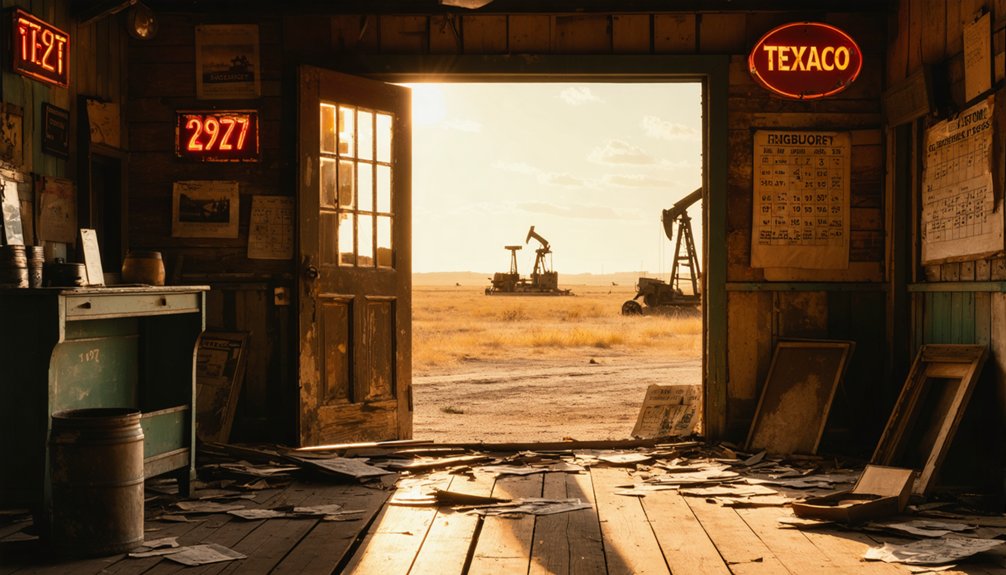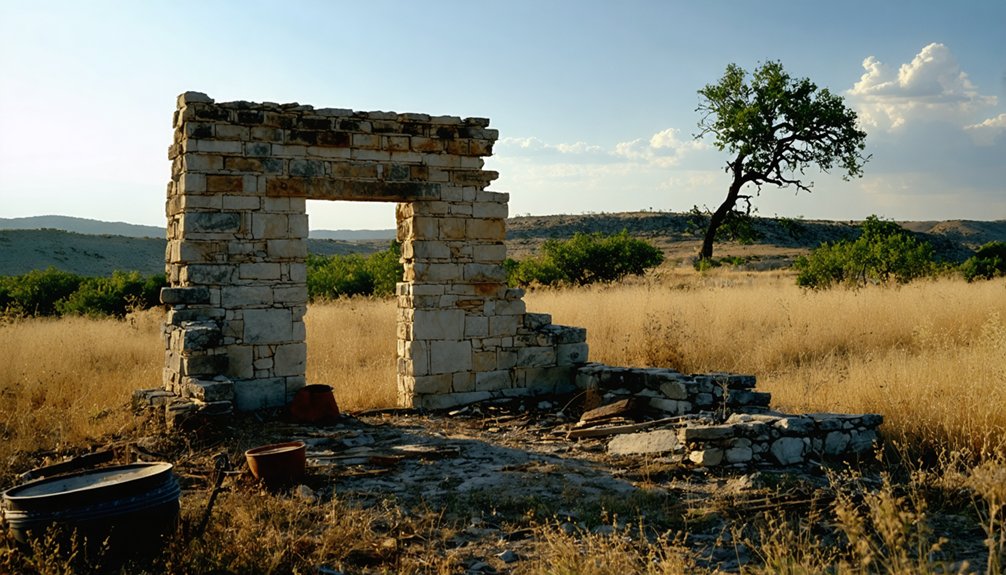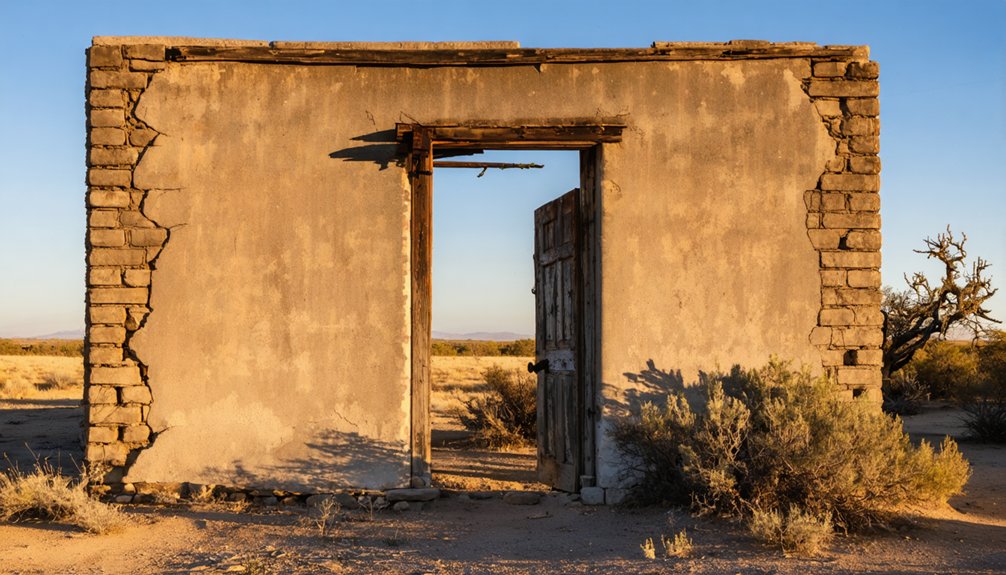You’ll find Spanish Fort, Texas at the convergence of Native American and European histories, where the Taovaya tribe and French traders established settlements in the 1700s. Despite its misleading name, no Spanish forces built this fort. The town flourished as a cattle trail trading post and birthed Justin Boots before declining into a ghost town of 50 residents. Its abandoned 1924 schoolhouse and archaeological sites hold fascinating tales of cultural exchange and economic transformation.
Key Takeaways
- Spanish Fort began as a Native American settlement and French trading post in the 1700s, despite its misleading name suggesting Spanish origins.
- The town flourished during the cattle-driving era, with H.J. Justin establishing his famous boot-making business there in 1879.
- By 2000, the once-thriving community had declined to approximately 50 residents, officially qualifying it as a ghost town.
- The 1924 brick schoolhouse stands empty today as a prominent reminder of the town’s former prosperity.
- Historical landmarks include the Stonewall Saloon site and a 1936 state monument marking the San Teodoro mission location.
Native American Origins and French Alliance
While many ghost towns emerged from short-lived mining booms, Spanish Fort began as a thriving Native American settlement established by the Taovaya band of the Wichita tribe in the mid-18th century.
Between 1750 and 1757, you’d have found two permanent villages on opposite banks of the Red River, with a population reaching up to 6,000 inhabitants. The settlement’s initial construction included a French trading post established around 1719. Colonel Diego Ortiz Parrilla led a Spanish retaliation force against the fortified settlement in 1759.
Straddling the Red River, twin villages housed thousands of Taovaya people during the mid-1700s, forming a thriving cross-river community.
The Taovaya Fortifications showcased impressive defensive engineering, featuring wooden stockades, strategic entrenchments, and a protective moat.
French Influence shaped the settlement’s development through essential trade partnerships and military alliances. You’ll find evidence of this strong relationship in historical records, where French traders documented the settlement flying their flag.
The French supplied the Taovaya with muskets and support, helping them maintain independence and control over regional trade routes.
The Myth Behind the Spanish Name
You’ll find that the “Spanish” in Spanish Fort represents a historical misnomer, as early Anglo settlers incorrectly attributed the ruins to Spanish colonizers rather than their true Wichita and French builders.
When you examine the physical evidence and historical records, they reveal that French traders helped the Taovaya, a Wichita tribe, construct the fortification around 1718 as a trading post and defensive structure. The settlement became a significant hub for horse and captive trading among native tribes. For better clarity in historical records, this location requires disambiguation efforts to distinguish it from other similarly named sites.
The misidentification stuck after postal authorities rejected the town’s original name “Burlington,” leading locals to officially adopt “Spanish Fort” based on the mistaken assumption about the ruins’ origins.
French, Not Spanish Origins
Despite its name, Spanish Fort was neither Spanish in origin nor built by Spanish forces. You’ll find that French influence shaped this historic site, as French traders from Louisiana collaborated with the Taovaya Indians to construct the fortification around 1719.
The settlement featured wooden stockades, entrenchments, and a moat that reflected both French and Native American architectural styles. Similar to these defensive structures, Fort Saint Louis in Texas had been established by French settlers decades earlier under La Salle’s leadership.
Historical misconceptions about the fort’s origins stem from Anglo settlers who found Spanish artifacts in the area years later. The truth is that French colonizers established strong trading partnerships with the Taovaya Indians, who built villages on both sides of the Red River. The Twin villages of Wichitas housed approximately 4,000 Native American inhabitants.
This strategic alliance aimed to counter Spanish expansion in the region, making the fort a vital outpost in the French effort to establish dominance in North America.
Early Settlers’ Mistaken Identity
When Anglo settlers stumbled upon the ruins near the Red River in the early 1800s, they made a crucial error that would persist in Texas history.
You’ll find that settler misconceptions shaped local understanding when they discovered Spanish artifacts among the abandoned fortifications. Without access to accurate historical records, they incorrectly assumed Spanish forces had built the installation.
The reality behind these ruins reveals:
- French traders and Taovaya Indians constructed the fort around 1718-1719
- Spanish forces never occupied the site until their failed attack in 1759
- Archaeological evidence points to French-Native American cooperation
- Historical accuracy was overshadowed by Anglo assumptions about Spanish dominance
This misidentification became deeply embedded in local tradition, with historical markers and place names perpetuating the error for generations to come.
Rise as a Cattle Trail Trading Post
Spanish Fort emerged as an essential trading post along the Shawnee Trail during the mid-1800s, capitalizing on its strategic location near the Red River crossing at Washita Bend.
You’d find this bustling outpost at the convergence of major trading routes, including the Old Spanish Road and Red River Santa Fe Trail, where cattle drives frequently stopped for supplies and rest.
The post’s strategic position made it a natural hub for commerce between Texas ranchers, merchants, and diverse Native American groups like the Comanche, Choctaw, and Chickasaw.
Holland Coffee established the area’s first trading post in the 1830s before moving his operations.
Merchants thrived on the steady flow of cattle moving northward, while steamship access via the Red River expanded trading opportunities.
The site’s proximity to cotton plantations and Indian Territory created a dynamic marketplace where pelts, hides, and various goods changed hands regularly.
The trading post became crucial for ranchers who typically earned ten dollars per head when selling their Texas Longhorns.
Justin Boots and Local Commerce
You’ll find the beginnings of Justin Boots in Spanish Fort’s bustling 1879 commerce, when H.J. Justin established his boot repair and custom bootmaking operation to serve trail riders near the Chisholm Trail’s railway terminus.
His innovative approach included self-measuring kits for cowboys and distinctive stitching patterns that would become hallmarks of Western boot design.
The business thrived through word-of-mouth among cattle traders until 1889, when Justin relocated to Nocona to capitalize on the expanding Missouri, Kansas and Texas Railroad network. Originally from Indiana, Justin built his reputation as a skilled leather craftsman and developed a successful mail-order business. His first pair of custom boots was crafted for a customer named Frank See and sold for $9.00.
Boots For Trail Riders
The establishment of Herman Joseph Justin’s boot shop in 1879 marked a pivotal development in Spanish Fort’s commercial landscape.
With just $35 and remarkable cowboy craftsmanship, Justin transformed a one-room shop into a thriving enterprise serving trail riders along the Chisholm Trail.
Justin’s boot innovation revolutionized the industry through:
- A unique self-measurement device that enabled remote ordering
- Custom-fit boots crafted specifically for long cattle drives
- Annie Justin’s pioneering mail-order system reaching distant territories
- Quality materials ensuring durability for weeks of horseback riding
You’ll find that Justin’s commitment to meeting cowboys’ needs perfectly aligned with Spanish Fort’s position as a key outfitting point.
His boots protected riders during grueling trail drives, while establishing a legacy that would help define Texas’s western identity and eventually reach 36 states and five countries.
Local Business and Growth
While Justin Boots began modestly in Spanish Fort, its evolution into a commercial powerhouse shaped the region’s economic landscape from 1879 onwards. H.J. Justin’s local entrepreneurship met the specific needs of cowboys along the Chisholm Trail, crafting boots that balanced durability with riding comfort.
You’ll find that boot manufacturing transformed from a small-scale operation into an industrial force when the company relocated to Nocona in 1889. Annie Justin’s innovative mail-order system expanded their reach beyond local boundaries to 36 states and five countries by 1915.
The company’s growth continued with their move to Fort Worth in 1925, where they established a massive factory spanning an entire city block. Their expansion created jobs, strengthened regional trade networks, and established Texas as a hub of Western boot craftsmanship.
Oil Boom and Economic Transformation

Following discovery of the Spindletop gusher in 1901, Spanish Fort’s economic landscape transformed dramatically as part of the broader Gulf Coast oil boom.
The region quickly developed infrastructure to support the burgeoning petroleum industry, with major companies establishing refineries and pipelines connecting the area’s oil fields.
Key developments during this economic transformation included:
- Construction of early refineries in nearby Sour Lake, just 20 miles away
- Rapid expansion of rail and barge connections to Port Arthur and Beaumont
- Establishment of major oil companies like Gulf Oil and Humble Oil (later Exxon)
- Development of extensive pipeline networks, including the 1905 Spindletop-Port Arthur line
This industrial growth shifted the region from its rural roots, as workers and speculators flooded the area seeking opportunities in the petroleum industry.
Archaeological Discoveries and Cultural Heritage
Recent archaeological excavations at Spanish Fort have revealed a complex narrative of European-Native American interactions through remarkable artifact discoveries.
You’ll find that contrary to its name, the site was actually a French-built trading post established around 1719 at a Taovaya Indian village, not a Spanish installation.
The archaeological significance of the site is evident in its defensive features, including wooden stockades, entrenchments, and a moat.
You can trace cultural exchanges through artifacts like French-cut gunflints, glass beads, and indigenous pottery scattered throughout the area.
The settlement’s strategic importance became clear in 1759 when French-allied Taovaya, Wichita, and Comanche forces successfully defended it against Spanish attackers, marking Spain’s earliest Texas defeat.
Ghost Town Legacy Today

Today’s Spanish Fort stands as a reflection of the gradual erosion of frontier settlements, with its population dwindling to approximately 50 residents by 2000. The ghost town‘s historical significance persists through its remaining landmarks and local lore, despite the closure of most businesses by 1970.
Spanish Fort whispers tales of the Old West through empty storefronts and quiet streets, a fading testament to frontier life.
- The 1924 brick schoolhouse remains standing but empty, serving as a silent reminder of the town’s former liveliness.
- The historic Stonewall Saloon location recalls the town’s cattle trail heritage.
- A state monument from 1936 marks the San Teodoro mission site.
- The old cemetery and “hanging tree” preserve memories of the town’s lawless past.
A devastating F4 tornado in 2009 further impacted the sparse infrastructure, yet Spanish Fort continues to draw visitors interested in Old West history and ghost town exploration.
Frequently Asked Questions
Are There Any Haunted Locations or Paranormal Activities Reported in Spanish Fort?
You’ll find local stories of ghost sightings near the old cemetery and hanging tree, though there aren’t documented haunted houses or verified paranormal activities beyond oral folklore and tourist tales.
What Happened to the Original Justin Boot Company Building in Spanish Fort?
Like boots worn thin by time’s march, the original Justin Boot building’s fate remains unknown. You’ll find no trace today – it likely succumbed to abandonment after the company’s 1889 move to Nocona.
How Can Visitors Access or View the Original Fort Site Today?
You can access the original fort site by driving to the historical marker at the end of Farm Road 103. There’s no standing fort – just the marker and surrounding landscape.
What Natural Disasters Have Impacted Spanish Fort Throughout Its History?
While flood damage and tornado impact aren’t documented, you’ll find disease was the major natural disaster, with smallpox epidemics devastating the indigenous Taovayan population from 1778 through the 1800s.
Were There Any Notable Gunfights or Wild West Incidents in Spanish Fort?
Like thunder on the plains, you’ll find the most significant gunfight in Spanish Fort’s wild west history was the 1759 Battle of Twin Villages, where native warriors outgunned Spanish colonial forces.
References
- https://www.redriverhistorian.com/post/spanish-fort-montague-county-texas
- https://www.youtube.com/watch?v=MPZiBJrtj6g
- https://texascooppower.com/mystery-of-spanish-fort/
- https://www.youtube.com/watch?v=sD5lbx4TJEI
- https://www.tshaonline.org/handbook/entries/spanish-fort-tx
- https://waurikanewsjournal.com/spanish-fort-texas-a-story/
- https://www.texasescapes.com/TexasGhostTowns/SpanishFortTexas/SpanishFortTexas.htm
- https://www.texasalmanac.com/places/spanish-fort
- https://en.wikipedia.org/wiki/Spanish_Fort
- http://talesntrails.org/native-american-culture.html



